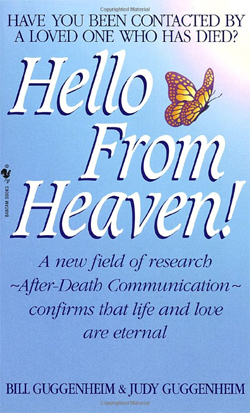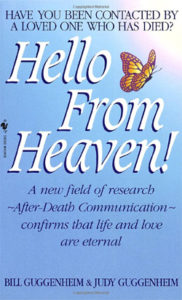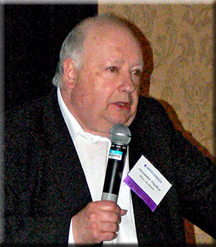Also see: White Paper on Transcommunication with emphasis on Electronic Voice Phenomena
What is EVP?
Electronic Voice Phenomenon (EVP) are intelligible voices found in recording media that have no known physical explanation. Many of the voices are thought to originate from deceased people. This is the primary reason that people first began experimenting with EVP.
Characteristics of the Voices
The recorded voices may be very quiet and may be difficult to hear and understand. Most EVP experimenters say that they have developed an “ear” for the sounds after learning to distinguish them from background noise. In transform EVP, the voices can often be recognized as male or female, young or old. Messages are seldom longer than two to four words. The words may be spoken very quickly, and there is often a distinctive cadence to the voices. Analysis shows that they are simulations of voice made from whatever sound is supplied, and are often missing voice box frequencies and have oddly arranged formants.
Types of Recording
In controlled conditions recording, it is possible to control ambient noise and supply special forms of background noise. Biofield energy is thought to accumulate in a “special” recording area, which is thought to help make contact. In field recording, it is difficult to control environmental conditions or supply background sound, but in known “haunted” locations, the energy helpful for contact may already be present.
EVP formed in an audio recorder by transforming available background sound is referred to as “transform EVP.” In this, it is sometimes possible to recognize the voice of the speaker. EVP formed by sweeping a radio dial, or with a computer program such as EVPmaker, are referred to as “opportunistic EVP” because sounds for voice formation must be made available on an “as needed” basis. Radio-sweep also known as “ghost boxes” or “spirit boxes,”), and in some applications, EVPmaker, depend on the use of “live” voice. ATransC will not use live voice examples for research because of the problem of undetected false positives. EVPmaker using synthesized voice is preferred for opportunistic EVP.
Environmentally stimulated speech synthesis is a relatively new and promising technique, but it should be noted that all speech synthesis approaches currently being tried do not support speaker recognition.
Recording Procedure
Recording Equipment
Digital voice recorders are recommended for transform EVP. Less expensive models produce more internal noise which is useful for voice formation. High-quality units will probably require added background noise. A computer can also be used, but will probably require added noise.
Scheduling
Entities will speak at any time of day or night. In the beginning, however, it is advisable to record at a regular time and place. By doing this, the entities learn when there will be an opportunity for contact and expectation of the upcoming session helps focus attention on the process. Try to find a place that will be quiet and free of interruptions. Background sounds are okay, but it is important to be aware of these so that they can be distinguished from the EVP.
Background Sound Source
Research has shown that for transform EVP, the entities use sounds in the environment to help form the words. Most recording situations have some background sounds, but it may be necessary to add noise with something like a fan or running water. Some people use foreign language radio, crowd babble or audio tapes; however, as more has been learned about EVP, the recommended practice has been to avoid the use of radio static or live voice of any form.
Preparation
Begin with meditation and a short prayer to ask for only those intending the highest good and an invitation to friends on the other side to participate. It is best to record when personal energy is the highest.
Recording
Vocalize your comments during an EVP session. The entities will often come through as soon as the recorder is turned on. These beginning messages may be the loudest, so it is a good idea to turn on the recorder and wait a few seconds before speaking. Questions should be recorded, and a period of time between each comment should be left for the entities to respond–about ten seconds. At the end, ask if the entity has something to say.
It may help to make an “appointment” with the intended entity the day before, during prayer or meditation. Some also provide feedback before the session so that the entities will know what worked in the last experiment. It is not necessary to record in the dark. People often try different devices and energy sources to help the entities communicate. Leaving written questions in the EVP experiment area the day before has worked for some.
Keep recording short. Recordings should be closely examined, at least until it is understood where to find the voices. A best practice for field recording is to use two recorders. As a rule, EVP will only occur on one recorder or sound track, making it possible to avoid mistaking local sounds for EVP (false positives).
Playback
In transform EVP, the voice is usually not heard until playback. Experimenters report that the voices tend to become stronger and clearer as the entities gain in experience, but at first, the voices may speak in whispers. Voices may not be recorded in every session and it may take several sessions to discover the first voice. Hearing the voices is a learned ability. It might take thirty minutes to examine a three or four-minute recording.
Classes of Voices
The following system of classification is based on a proposed Best Practice at atransc.org/classifying-phenomena/. You are invited to participate in developing the practice. Please use the Contact tool to let us know you are interested.
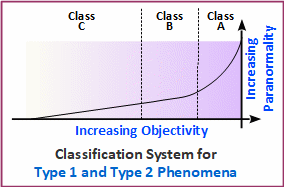 A distinction is made between phenomena which are always present and phenomena which are transient features. A face seen in the decomposition pattern of a leaf is more or less always there, as opposed to a face found in moving water or video-loop noise. As a general rule, “always there” phenomena appear to be formed by opportunistically adapting naturally occurring processes to express the message, assuming one is intended. If perceived as phenomena, “always there” features would be considered Type 2.
A distinction is made between phenomena which are always present and phenomena which are transient features. A face seen in the decomposition pattern of a leaf is more or less always there, as opposed to a face found in moving water or video-loop noise. As a general rule, “always there” phenomena appear to be formed by opportunistically adapting naturally occurring processes to express the message, assuming one is intended. If perceived as phenomena, “always there” features would be considered Type 2.
 Features found in ever-changing noise are thought to be formed by transforming that noise into the voice or face. While the resulting features are fleeting unless caught in media (photograph or audio recording), they tend to be better formed and more easily identified as anomalous. So for both audible and visible phenomena:
Features found in ever-changing noise are thought to be formed by transforming that noise into the voice or face. While the resulting features are fleeting unless caught in media (photograph or audio recording), they tend to be better formed and more easily identified as anomalous. So for both audible and visible phenomena:
Type 1: Transformed physical media; not always present
Type 2: Always present; often as a persistent artifact
Both Type 1 and Type 2 examples are divided into three classes:
Class A: Evident without explanation
Class B: May require directions
Class C: Maybe vaguely experienced; mostly obscured by noise
Keeping a Log
Maintaining a record of recording results is very helpful. Include the date, time, seconds into the recording, the message itself and the question asked. Be sure to label and save the audio file so that they can be found at a later time. Experimenters report that they feel weather may affect results, but this has not been well studied.
Digital Voice Recorders
Digital voice recorders are recommended for EVP experiments. Today, all sound-tracks—digital or analog—should be listened to in a computer and with a headset. Unlike tape recorders, the built-in microphone is usually satisfactory for EVP. Consider the selection guide for audio recorders here. Audacity is an effective audio management program that can be downloaded at no cost.
Computer Recording
A computer instead of a digital recorder can be used for recording EVP. It should have an audio input jack, speakers, headphone jack and sound player application such as Audacity. Most experimenters use the computer to analyze and store examples. If the recorder does not have a USB interface, it is possible to play the recording into the computer while recording with a recorder program. The Earphone jack of the recorder can be connected to the Microphone or Line 1 jack via a cable. The sound source should be set to the correct jack via the pull-down menu in Audacity. Recording with a sample rate of 11025, mono and 16-bit resolution is sufficient for EVP. Files should be edited as *.wav format but shared as *.mp3.
Analyzing the Recording for EVP
Always use headphones when listening to the recording on a computer. The earmuff style that completely covers the ear is best, but also good are the soft rubber earbuds that are inserted in the channel of the ear.
Be sure to set up a method of saving your recordings in your computer that will allow you to easily locate examples. A good practice is to save the raw recording session in a dated folder and then also save clips containing the EVP in the same folder. Field recordings are saved under the name of the location and the date. It is helpful to keep a separate folder for your Class A examples for easy retrieval for demonstration to friends. ATransC follows the labeling practice of (c)lisa_butler2008-what_evp_says.mp3. The (c) symbol indicates the intention to protect rights to the example. If you are making the example available under the Creative Commons license, then use (cc) instead of (c). Using first and last name helps sort many examples in the folder for easy retrieval. The underline and dash symbol with no use of capitals helps assure that computer systems and the Internet accepts the name. A 200 kb audio file can be reduced to around 15 Kb when converted from a *.wav file to an *.mp3 file. This makes it easy for sharing files via the Internet.

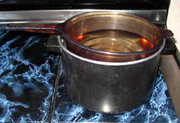 As Margaret Downey explains her experimental set-up, “I have a Canon PowerShot A75 Digital camera. It allows me to do thirty seconds of video at a time. I leave it on the highest resolution (640 x 480 pixels). For effects, I use the function button to set the camera to shoot in sepia (a brownish tone), tungsten (which makes it blue), and black and white. I also do a session using just normal settings.
As Margaret Downey explains her experimental set-up, “I have a Canon PowerShot A75 Digital camera. It allows me to do thirty seconds of video at a time. I leave it on the highest resolution (640 x 480 pixels). For effects, I use the function button to set the camera to shoot in sepia (a brownish tone), tungsten (which makes it blue), and black and white. I also do a session using just normal settings. “Once in awhile, I’ll place a crystal or a crystal ball in the water. And sometimes I ask my hubby to shine red and blue lights in the water.
“Once in awhile, I’ll place a crystal or a crystal ball in the water. And sometimes I ask my hubby to shine red and blue lights in the water. In one experiment, Margaret asked for her grandparents and received this ITC picture of a bearded man she feels is her Great Great Grandfather, Benjamin Franklin Main Sr. He was a physician and Baptist minister who crossed in 1913. Today, he and his grandson, Lewis (Margaret’s grandfather who crossed in 1993), help her in making connections to other people.
In one experiment, Margaret asked for her grandparents and received this ITC picture of a bearded man she feels is her Great Great Grandfather, Benjamin Franklin Main Sr. He was a physician and Baptist minister who crossed in 1913. Today, he and his grandson, Lewis (Margaret’s grandfather who crossed in 1993), help her in making connections to other people.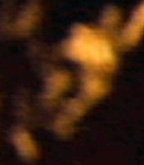 Margaret also has captured a picture of a face that she feels is her Indian guide, Walking Sun, who she had asked to come through during an experiment. Margaret had a reading from a Shaman who told her, “Margaret’s heart hears the drum beat of Mother Earth and her spirit finds the stairway to Father Sky.” She told Margaret that if she asked for her guide, Walking Sun, he would come. Margaret says, “One of the Shaman’s comments in my reading was that people with “dove medicine” can see between the worlds and the veil between earth and the spirit world is thin for them. She talked about being clairaudient and hearing spirit/sensing vibrations. It was so fun to be able to tell her after the reading about EVP/ITC!”
Margaret also has captured a picture of a face that she feels is her Indian guide, Walking Sun, who she had asked to come through during an experiment. Margaret had a reading from a Shaman who told her, “Margaret’s heart hears the drum beat of Mother Earth and her spirit finds the stairway to Father Sky.” She told Margaret that if she asked for her guide, Walking Sun, he would come. Margaret says, “One of the Shaman’s comments in my reading was that people with “dove medicine” can see between the worlds and the veil between earth and the spirit world is thin for them. She talked about being clairaudient and hearing spirit/sensing vibrations. It was so fun to be able to tell her after the reading about EVP/ITC!”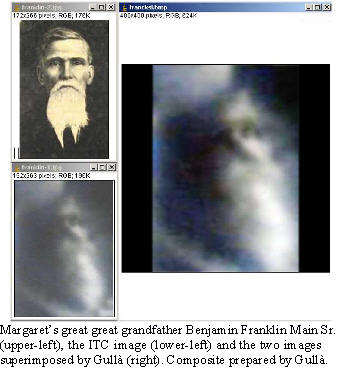 In the last NewsJournal, we reported about how Margaret Downey conducts visual ITC experiments using moving water for optical energy. The article can be read in the
In the last NewsJournal, we reported about how Margaret Downey conducts visual ITC experiments using moving water for optical energy. The article can be read in the 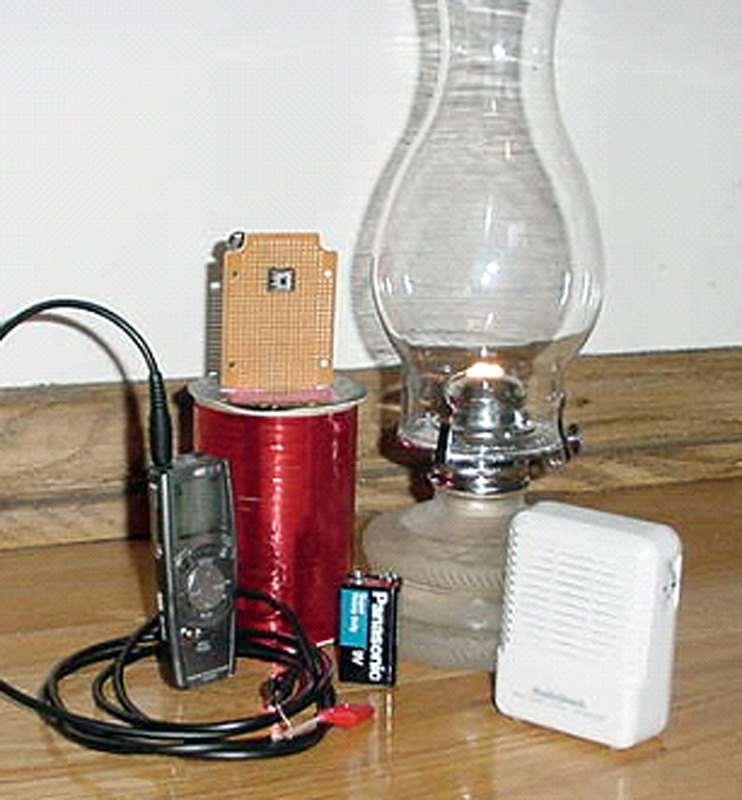


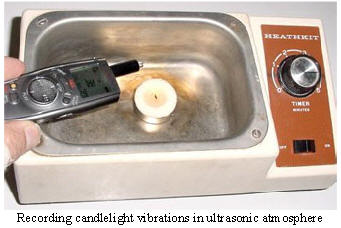
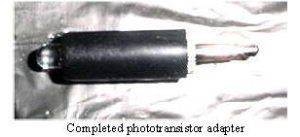 This article presents an experimental approach for making EVP recordings. Its purpose is instructional and to help promote an understanding of vibrational energy and how we may better perceive it.
This article presents an experimental approach for making EVP recordings. Its purpose is instructional and to help promote an understanding of vibrational energy and how we may better perceive it. The technique involves use of a single, widely available electronic component called a phototransistor. This is not the same as a diode which was used by early EVP researchers. The phototransistor I recommend is available at any Radio Shack store or available from them online. The part number is 276-145. My tests have shown that the device is responsive to infrared, visible and ultraviolet light. All of these frequencies of light mentioned are well above radio broadcast, cell and microwave transmission frequencies.
The technique involves use of a single, widely available electronic component called a phototransistor. This is not the same as a diode which was used by early EVP researchers. The phototransistor I recommend is available at any Radio Shack store or available from them online. The part number is 276-145. My tests have shown that the device is responsive to infrared, visible and ultraviolet light. All of these frequencies of light mentioned are well above radio broadcast, cell and microwave transmission frequencies.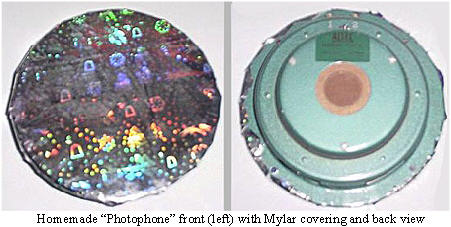 Solder the phototransistor to the phone plug as follows: The phototransistor has a flat edge on its case, this is the collector mark. The remaining lead is called the emitter; Connect (solder) the collector to the short pin of the phone plug; and, the emitter connects to the long pin of the phone plug. The photo shows the completed assembly ready for use.
Solder the phototransistor to the phone plug as follows: The phototransistor has a flat edge on its case, this is the collector mark. The remaining lead is called the emitter; Connect (solder) the collector to the short pin of the phone plug; and, the emitter connects to the long pin of the phone plug. The photo shows the completed assembly ready for use. For example, a quartz-tube space heater at full power (glowing) will produce a very pure thermal white noise. Place the recorder in your car and drive around. You may be surprised at what you can hear in the filtered sunshine as the levels of light change as you drive. If you have a crystal or mineral collection you may try recording reflections or direct light shined through a crystal (sunshine, LED flashlight or a laser pointer works well).
For example, a quartz-tube space heater at full power (glowing) will produce a very pure thermal white noise. Place the recorder in your car and drive around. You may be surprised at what you can hear in the filtered sunshine as the levels of light change as you drive. If you have a crystal or mineral collection you may try recording reflections or direct light shined through a crystal (sunshine, LED flashlight or a laser pointer works well). Hold the completed Photophone so sunlight reflected from the surface of the shiny, flexible mirror shines on the phototransistor. Now speak closely and loudly to the surface of the Photophone. On playback you should hear your own voice. The quality will depend on how well your voice vibrates the surface of the Photophone. For more controlled experiments, you can connect the loudspeaker to a stereo or amplifier and play different sounds through it to vibrate the film. Just place the speaker so that sunlight reflects from the surface to the phototransistor. Try using music, Spiricom tones, babble or even white noise, as an example.
Hold the completed Photophone so sunlight reflected from the surface of the shiny, flexible mirror shines on the phototransistor. Now speak closely and loudly to the surface of the Photophone. On playback you should hear your own voice. The quality will depend on how well your voice vibrates the surface of the Photophone. For more controlled experiments, you can connect the loudspeaker to a stereo or amplifier and play different sounds through it to vibrate the film. Just place the speaker so that sunlight reflects from the surface to the phototransistor. Try using music, Spiricom tones, babble or even white noise, as an example.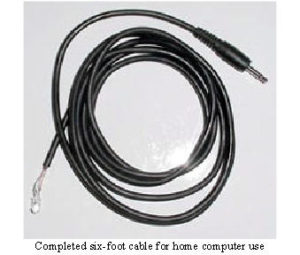 You may wish to build a phototransistor cable that can be used with your home computer sound card for recording. The Radio Shack part number of the cable to use is 42-2434. The six-foot cable has a molded 1/8” plug on one end and tinned leads on the other end, ready to connect the phototransistor. The connections are as follows: inner conductor of cable connects to phototransistor collector (flat edge), outer (shield) connects to emitter.
You may wish to build a phototransistor cable that can be used with your home computer sound card for recording. The Radio Shack part number of the cable to use is 42-2434. The six-foot cable has a molded 1/8” plug on one end and tinned leads on the other end, ready to connect the phototransistor. The connections are as follows: inner conductor of cable connects to phototransistor collector (flat edge), outer (shield) connects to emitter.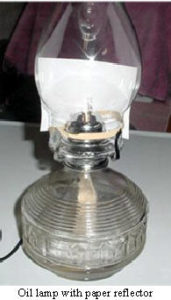 these lamps is cotton and works well. I have begun tests with other wick materials as of this writing. I attach the phototransistor and cable assembly to the lamp with a thick rubber band. A reflector is required to be placed behind the phototransistor. A white 3 x 5-file card is excellent for this purpose. This simple reflector greatly increases the gain of the microphone. If your sound card allows audio monitoring, you can experiment with the flame level for best reproduction of your voice. A high flame level can overload the phototransistor. Start with a low flame and ratchet it up slowly. Speak into the chimney of the lamp or across its top if you are sensitive to the exhaust fumes. Use an ultra-pure liquid paraffin lamp fuel for lowest odor.
these lamps is cotton and works well. I have begun tests with other wick materials as of this writing. I attach the phototransistor and cable assembly to the lamp with a thick rubber band. A reflector is required to be placed behind the phototransistor. A white 3 x 5-file card is excellent for this purpose. This simple reflector greatly increases the gain of the microphone. If your sound card allows audio monitoring, you can experiment with the flame level for best reproduction of your voice. A high flame level can overload the phototransistor. Start with a low flame and ratchet it up slowly. Speak into the chimney of the lamp or across its top if you are sensitive to the exhaust fumes. Use an ultra-pure liquid paraffin lamp fuel for lowest odor.